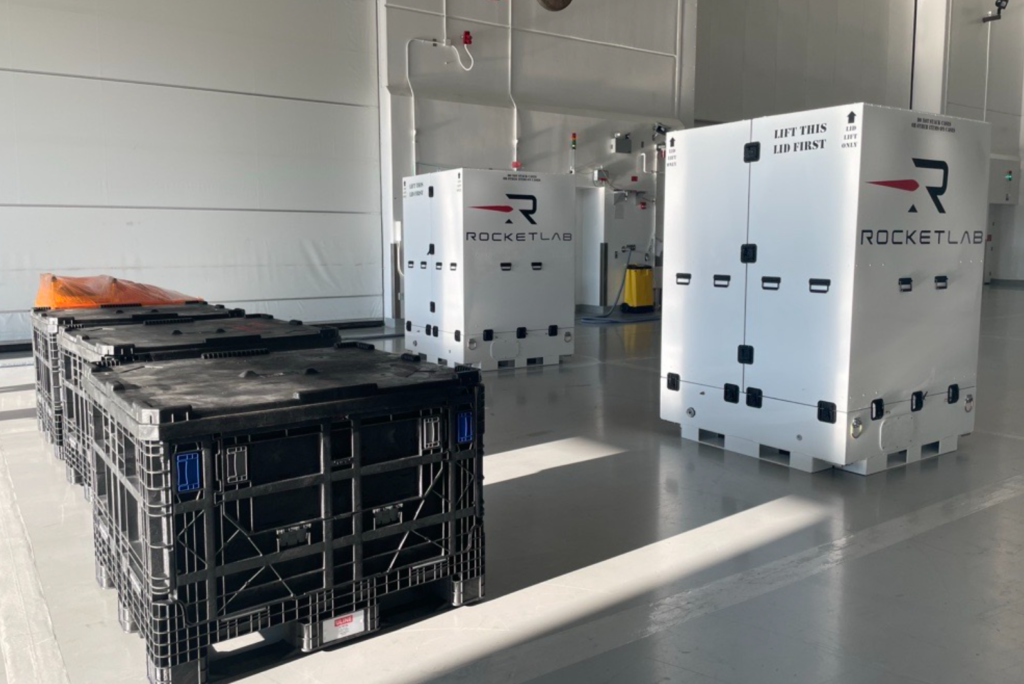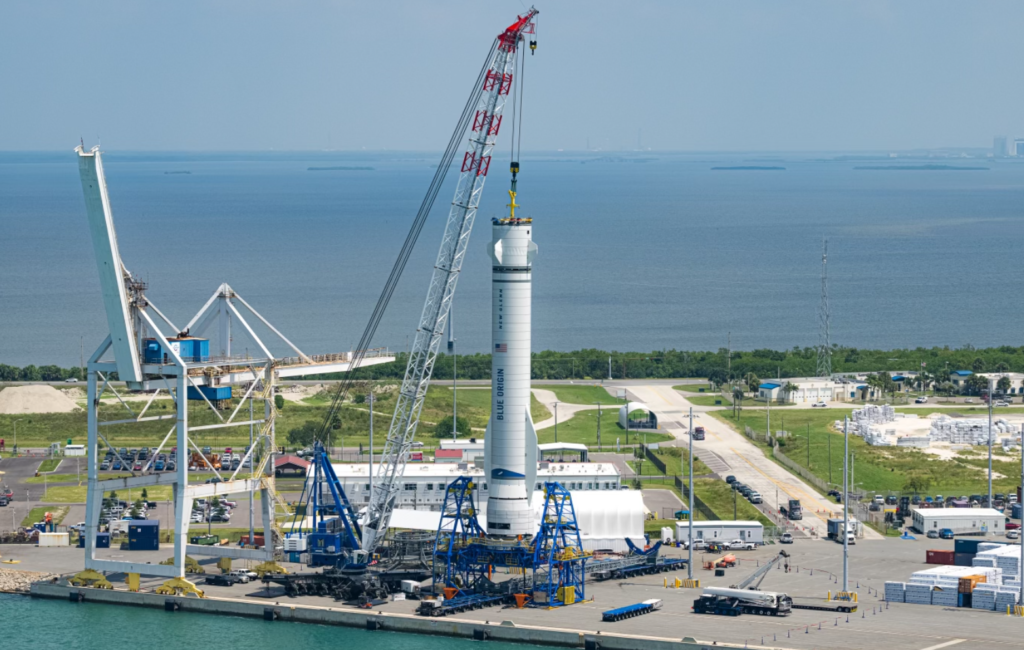As of right now, Blue Origin is still pushing toward a launch of New Glenn by the end of the year. With it already being late August, this means they are hoping to launch in just a few months. Despite normally keeping most development and progress to themselves, with big tests and licenses needed we’re starting to see more work and preparation.
Only days ago the official payload for this mission, two satellites built by Rocket Lab in partnership with NASA, were shipped and just arrived in Florida for integration. Here I will go more in-depth into this newest development, New Glenn testing, overall progress, and more.
Payload Arrival

Back in early 2023, NASA selected Blue Origin to launch the ESCAPADE or Escape and Plasma Acceleration and Dynamics Explorers Mission. In summary, it’s a mission to Mars that intends to orbit two spacecraft meant to study the planet’s magnetosphere. On August 16th, Rocket Lab shipped the two spacecraft and yesterday they finally arrived. They tweeted saying, “Delivered to Florida & ready for Mars. After a four-day, 2,560-mile journey across the U.S., our ESCAPDE twin spacecraft for ucbssl and NASA have made it to Astrotechspace in prep for lift-off. The twins have been unboxed & in the coming days we’ll start integration with the launch vehicle.”
The last sentence is significant as it highlights that they are practically ready for the primary payload integration with New Glenn. That being said, there is still quite a bit of work left in order for the mission to lift off on schedule. Given the current date, Blue Origin is going to need practically all of its upcoming tests such as static fires and wet dress rehearsals to go without a hitch.
Most recently the company conducted recovery operations of the first stage. In a statement on Aug 8th, they said, “Port Canaveral spectators got a sneak peek of our recovery operations today as we demonstrated the process of transitioning New Glenn’s first stage from vertical to horizontal using our 200-foot-tall simulator. The operation validated our tooling and procedures for recovering our first stage from the landing vessel, bringing us another step closer to our first launch.”
Just a few days after an FCC or Federal Communications Commission document was released that shed even more light on the company’s recovery prep. Here, under the purpose of operation, it was quoted as saying, “Blue Origin (New Glenn Program) needs to perform a test verification and validation activities of Marine antenna systems while offshore near the Port of Cape Canaveral, FL To perform a test verification and validation of Marine antenna systems with a flying helicopter simulating an attitude of a launch vehicle over the Atlantic ocean approx. 12nm from Port of Cape Canaveral This will be a one-time test, and once conducted it will not be required for the entire duration request of the STA.
In other words, they are going to test a simulated landing sometime in September. The specific operation start and end date is September 5th to September 18th. This is another good sign in terms of progress but also helps put in perspective the amount of work necessary before the maiden flight of a new rocket. These extra steps all put additional pressure on the vehicle’s launch timeline and whether or not it can stay on schedule.
It’s important to point out that this mission is classified by NASA as higher risk regarding the schedule. Specifically, it’s a Class D mission which the agency describes as low priority and high risk. They also say that “Medium or significant risk of not achieving mission success is permitted. Minimal assurance standards are permitted.” This takes some pressure off Blue Origin as it’s not the end of the world if they miss the launch timeline however they seem adamant about launching this year.
Since early this year, we were hearing comments from various officials saying late September would be the launch date. For example, during a presentation in April, NASA’s planetary protection officer, listed a Sept. 29 date for the launch of the Escape and Plasma Acceleration and Dynamics Explorers (ESCAPADE) mission. Even more recently, just a few months ago Space Force officials also noted a September launch. Based on updates from the company along with progress, a launch in October or November seems much more realistic, but still ambitious. This is also a mission to Mars which means the time period to launch is somewhat limited based on the Earth’s orbit relative to Mars. Something to keep in mind as we get closer to a possible launch date and mission.
New Glenn Progress

In addition to the payload’s arrival, we’ve started seeing much more of both presumed flight hardware along with structural test units going through different developments. Starting last month, Blue Origin reported that they completed New Glenn’s first stage test of its six landing legs. With reusability a core part of New Glenn’s framework and future, the landing legs will play an important role in the future success and even the time between launches. In this specific test, you can see the landing gear which is stowed inside the rocket during flight, deploying like it would if the booster was gently touching down on the vessel.
Moving toward the top of the rocket, even more recently on August 7th, Dave Limp, the CEO of Blue Origin, shared quite a bit of info on the forward module and relevant testing. In one example he said, “This forward module validation test is fun to see. Our four fins on New Glenn are about the size of a car—roughly 16 feet long at the base and sticking out 6.5 feet from the body of the rocket. They’re responsible for steering the rocket on ascent and descent. Most of the structure is aluminum, which is protected from reentry heating by a durable fabric thermal protection system we invented and refer to internally as ‘Comet.’ The aerodynamic forces pushing on the fin during flight are roughly equal to the weight of a 737 aircraft” he said. Included was footage of testing on the ground.
They not only were testing the fins but also the forward module thrusters. In another statement, he mentioned, “This is our Reaction Control System thrusters firing. This system corrects New Glenn’s orientation in zero-g and just before landing on our vessel at sea. Together, the thrusters and the forward fins I mentioned earlier are essential to the booster’s reusability.”
These tests were likely performed quite a while ago but only just recently shared. Blue Origin keeps a lot of their progress and development to themselves which can make estimates regarding a launch difficult. However, as the tests get bigger and require major infrastructure like the launch pad, it obviously becomes harder to hide.
Another key part of New Glenn’s maiden flight and foreseeable future is the BE-4 engine. While Blue Origin hasn’t flown any yet on their own rockets, ULA has, and various reports are coming out that suggest production has ramped up quite a bit. By June of this year Tory Bruno, the ULA CEO had commented that they had now received all the BE-4 engines needed for ULA’s 2024 manifest. Other reports point out that testing and engine qualification have increased as Blue Origin works to get even more engines out the door.
This is going to be a very important process going forward. It’s one thing to consistently deliver two BE-4 engines per Vulcan rocket but 7 for a single New Glenn is a substantial increase. It’s also worth pointing out that even though the first stage is reusable which in theory would help reduce the number of engines needed, the maiden flight along with some of the subsequent missions may not have a 100% successful booster landing. New Shepard provides a good starting point but New Glenn is significantly larger, more powerful, and landing out at sea on a new vessel. All of which increase the risk of the mission.
The actual landing vessel has also made progress after the switch from the original ship named Jacklyn. Images were captured of the vessel offshore. Initial estimates put the platform size at around 150ft by 380ft or 46m by 115m. For reference, SpaceX’s barges such as Just Read The Instructions is 170ft by 300ft or 52m by 91m. That would put the two at a similar size with Blue Origin’s version being even longer. The structures are also quite different as SpaceX’s droneships are mostly flat across the entire platform. The first test and actual landing attempt should be exciting and give us a better idea of the exact plan, securement method, etc. In the coming weeks, we should expect even more testing leading up to an eventual static fire and wet dress rehearsal.
Conclusion
Blue Origin is making a push toward the maiden flight of New Glenn, a partially reusable heavy-lift launch vehicle. It’s been a long time coming, but we are starting to see actual testing and permits leading up to flight. Even still, there are a number of mission-critical tests left before the first flight-capable New Glenn is on the pad and attempts to lift off. We will have to wait and see how it progresses and the impact it has on the space industry.
